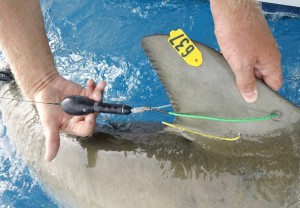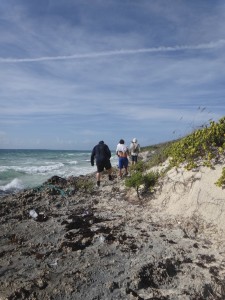
Last Thursday our shark team, captained by Dr. Edward Brooks, embarked on another exciting satellite tag recovery to the Exumas – a small group of cays situated due west of the Cape Eleuthera Institute. This particular project, run in collaboration with Microwave Telemetry Inc, has deployed eight Microwave Telemetry X-Tags over the last two years. This particular PSAT had popped off a male Caribbean reef shark (Carcharhinus perezi) after five months, three months earlier than its planned 8 month deployment, due to a failure of the tag anchor. The X-Tag has been logging the depth and temperature of the shark every two minutes, in addition to logging ambient light levels, from which daily geolocation estimates can be generated from day length and sunrise and sunset times.

These tags are not designed to be recovered, instead transmitting their archived data via the ARGOS satellite system. Typically 100% data transmission is not achieved due to limitations in battery life and satellite bandwidth, so if a tag washes ashore it provides a rare opportunity for 100% of the logged data to be recovered manually. The two minute resolution data will yield a treasure trove of information on this poorly understood species.
At 6:30am the team readied the boat with all necessary gear for a long day out in the field. The two most important items aboard consisted of a GPS with approximate location of the last transmission, and a VHF receiver and yagi antenna to narrow the search area from the individual burst transmissions from the tag. Timing is imperative, as detections from the tag only transmit during a two-hour window when the satellite is directly above the tag’s location. Transmissions were in one-minute intervals, between 9:15 and 11:15, meaning the team had to arrive at the Exumas no later than 9 am in order to anchor the boat and assemble the GPS and satellite receiver.
The team set out at 7 am on the ‘Simon Says’ into relatively windy conditions and a following sea to begin the 30 nautical mile journey west of Eleuthera, heading directly towards the top of the Exuma island chain. Despite the rough conditions, they arrived on site within 63 minutes, an hour ahead of schedule. The search area consisted of a relatively small island at the top of the Exuma island chain called Shipping Channel Cay; and so the search began. With time on their side, they promptly anchored the boat in a small cove on the north side of the island, out of the wind, and snorkeled their kit and tools ashore. They then trekked for 1.2 miles through sharp spiny bushes and a jagged limestone coastal platforms, also know as ‘death rock’ to a small beach on the eastern side of the island, believed to be the most likely retrieval point of the tag.
As Edd set up the satellite receiver, the team eagerly anticipated the arrival of 9:15, hoping the receiver would detect some sort of radio signal so we could use our two hour window wisely, as the heat of the day was already upon them. As. 9:15 soon approached and passed, the situation began to look rather bleak without any sign of life from the receiver.
Suddenly, at 9:22am there was a small ping from the receiver; the satellite tag was alive and kicking! The team now knew the tag must be somewhere relatively close on the island, but where exactly? The team began walking up and down the beach, scrambling along various cliff tops following the direction of strongest transmission.
Very quickly they realized something strange was happening, as the tag did not seem to be transmitting every 60 seconds. The team soon concluded the tag could well be trapped within large patches of Sargassum seaweed that was being thrown against the bottom of the cliffs by strong waves, which was preventing consistent transmission. Members of the team proceeded to jump into water to start sifting through the knots of Sargassum. Through the crashing waves, Edd yelled, confirming a sighting of the tags antenna peaking out of a Sargassum patch.